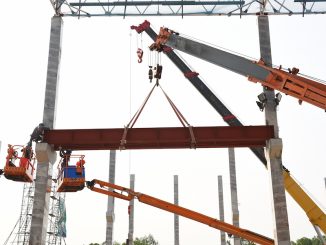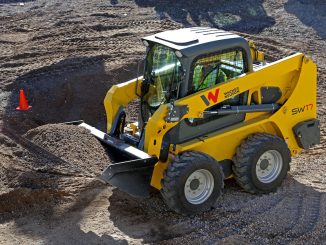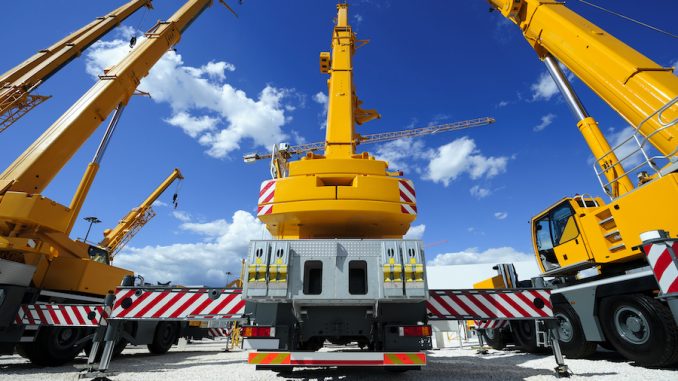
View the complete article here.
Cranes provide the muscle to lift, lower, and move heavy materials that make various types of projects around the world possible. From the towering skyscrapers that define our city skylines to the intricate roadways that connect communities, cranes are a fundamental component of building and development. The purpose of this article is to guide contractors through the process of selecting the most appropriate crane, tailored to the specific demands of their projects—ensuring that the critical aspects of functionality, safety, and cost-efficiency are thoroughly addressed.
Understanding the Different Crane Types
Choosing the right crane is a critical decision in project planning that can significantly affect both the efficiency and safety of your operations. Here’s an overview of some common crane types, their advantages and disadvantages, and the scenarios they are best suited for…
Mobile Cranes
Mobile cranes are the most versatile type of crane and are mounted on wheels or crawlers to facilitate movement. They can lift heavy loads and come in a range of sizes and capacities.
- Advantages: High mobility, quick to set up, and suitable for a variety of terrains.
- Disadvantages: Limited by their weight and height capacity compared to stationary cranes—require a flat, stable surface for operations.
- Ideal use-case scenarios: Short-term projects, sites where crane needs to be moved frequently, and projects with varying lift locations.
Tower Cranes
Tower cranes are a common addition to construction sites where taller structures are being built. They have a vertical mast and a jib that extends horizontally.
- Advantages: Excellent for height and vertical lifting, can lift loads to great heights, and stable and efficient for long-term projects.
- Disadvantages: Requires time to assemble and disassemble, not mobile, and requires significant space for operation.
- Ideal use-case scenarios: Construction of high-rise buildings, as well as large-scale urban development projects.
Telescopic Cranes
Telescopic cranes offer a boom that consists of a number of tubes fitted one inside the other. A hydraulic mechanism extends or retracts the tubes to increase or decrease the length of the boom.
- Advantages: Versatile lifting capacity, can be adjusted for height and reach, and quick setup.
- Disadvantages: Less stable at maximum extension, and limited by boom length.
- Ideal use-case scenarios: Short-term projects requiring high versatility, rescue operations, and projects with space constraints.
Crawler Cranes
Crawler cranes are heavy-duty cranes that move on tracks instead of wheels, providing stability on various terrains.
- Advantages: Capable of traveling with a load, stable, and excellent for heavy loads and on soft grounds.
- Disadvantages: Slow movement, and difficult and expensive to transport as they often need to be disassembled.
- Ideal use-case scenarios: Long-term projects on large construction sites, and operations on uneven or soft terrain.
Rough-Terrain Cranes
Rough-terrain cranes are designed to operate on uneven and rugged surfaces. They are four-wheeled and have outriggers for stability.
- Advantages: Highly maneuverable, can work in confined areas, and designed for off-road construction sites.
- Disadvantages: Not ideal for soft soils without proper preparation, and limited by travel speed on public roads.
- Ideal use-case scenarios: Construction sites with uneven terrain, and projects in remote or undeveloped areas.
Each type of crane is suited to specific situations and environments. Factors like lift requirements, site access, terrain, and project duration will all influence the decision on which crane type is the best fit for a project.
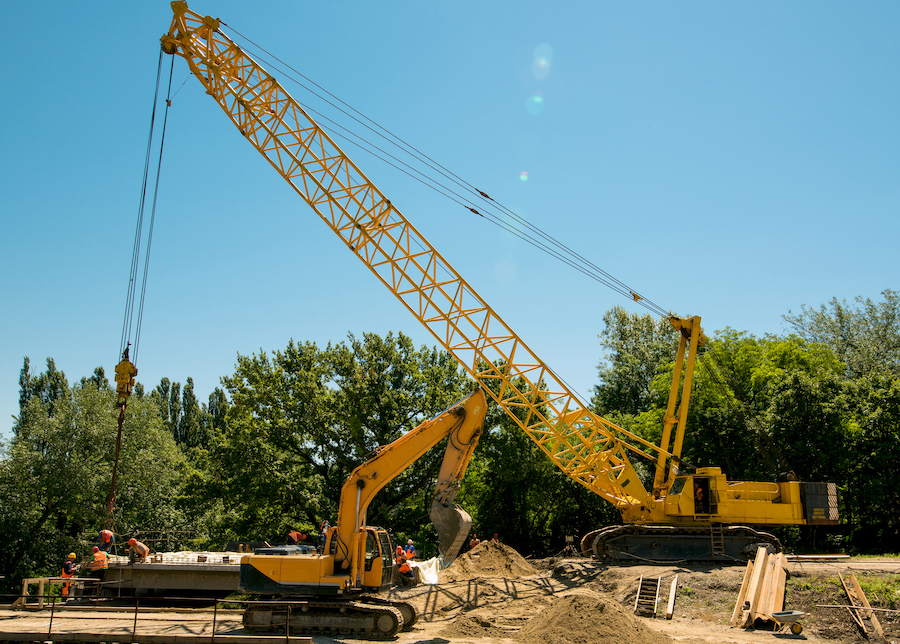
Assessing Project Requirements
Selecting the right crane is not just a matter of preference but a strategic decision based on the specific demands of your project. It requires a detailed assessment of various factors to ensure that the crane you choose can handle the requirements safely and efficiently.
Understanding Project Specifics
The load weight of the materials to be lifted is the most critical factor, which determines the crane capacity required. Overloading can lead to equipment failure, while underutilization may mean spending more than necessary.
The lift height at which the materials need to be lifted will affect the type of crane, especially its boom length and type. High-rise projects often necessitate cranes with longer reach and higher lift capacities.
The ground condition on the site will influence whether you need a crane with tracks for stability on soft ground or one with tires for maneuverability on hard surfaces.
How easily the crane can access and move around the site is crucial. You may need a crane that can be transported in sections and assembled on-site if access is restricted.
Evaluating Site Conditions
The amount of space available for the crane to operate can greatly limit your choices. Cranes that require minimal setup area, like mobile or city cranes, might be necessary in tight spaces.
Ground conditions like soil stability and bearing capacity can determine if you need outriggers or mats to distribute the load. Crawler cranes might be preferred on less stable ground.
The local weather, such as high winds, can affect crane operations. Tower cranes and mobile cranes may have different thresholds for wind speeds and might require weather service subscriptions for real-time data.
Urban Versus Rural Projects
Urban environments often have tighter spaces, more regulations, and greater concerns about noise and disruptions. Cranes that can be erected and moved with minimal impact on the surrounding area, like electric or hybrid models, may be beneficial.
Rural projects may have more space but also more challenging terrain. Cranes with robust off-road capabilities, like rough-terrain cranes, are often necessary.
By evaluating these factors, you can ensure that you choose a crane that not only meets the project’s technical demands but also adheres to safety standards, budget constraints, and timelines.
Safety Considerations
Understanding and adhering to established safety standards, ensuring proper certifications, and having emergency procedures in place are not just regulatory requirements but also critical to the smooth and safe execution of a project.
Safety Standards and Regulations
In the United States, the Occupational Safety and Health Administration (OSHA) and American National Standards Institute (ANSI) provide guidelines that must be followed when operating cranes. These include specifications for design, inspection, and operations.
Depending on your location, there may be additional local codes that govern crane operations. Internationally, standards such as those from the International Organization for Standardization (ISO) may apply.
Regular load testing and inspections are required to ensure the crane is functioning safely. Any crane chosen must be able to pass these tests as per the relevant standards.
Crane Operators and Certifications
Crane operators must be certified by accredited bodies to ensure they have the necessary skills and knowledge. In the U.S., certifications are typically obtained through organizations such as the National Commission for the Certification of Crane Operators (NCCCO).
Beyond initial certifications, operators should engage in continuous training to keep up with new technologies and safety practices.
Other personnel, such as signal persons and riggers, also play vital roles in crane safety and must be properly trained and certified.
Emergency Procedures and Safety Protocols
Before crane operation begins, a comprehensive emergency plan should be in place. This plan should include procedures for dealing with potential accidents such as tip-overs, electrical contact, and mechanical failures.
Daily safety briefings and regular drills can ensure that all personnel are prepared for an emergency. Safety protocols also include proper communication systems and the use of personal protective equipment (PPE).
Keeping detailed records of maintenance, inspections, and any incidents is crucial. These documents can be vital in both preventing future accidents and in responding to any that occur.
Selecting a crane with the appropriate safety features and ensuring that the operators and staff are fully qualified and prepared for emergency situations is crucial. Ignoring these considerations can lead to severe consequences—both in terms of project costs and, more importantly, human safety.
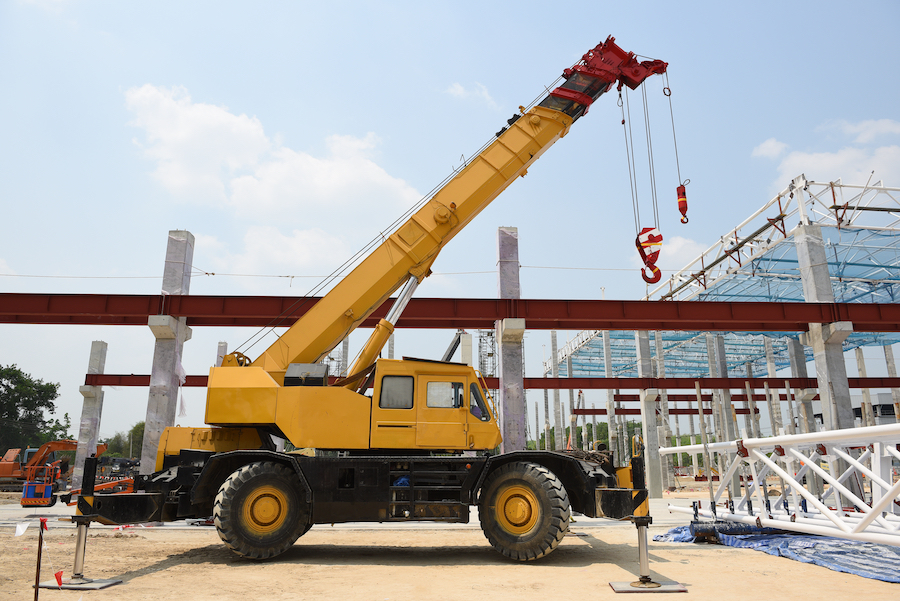
Cost and Efficiency
Efficient management of financial resources is key to the success of any project. In the context of crane operations—this means conducting a thorough cost-benefit analysis of crane options, understanding the implications of crane selection on project timelines, and employing strategies to optimize costs.
Cost-Benefit Analysis of Different Cranes
The initial price of a crane is just one part of its overall cost. Maintenance, operating costs, and potential resale value should also be considered.
Renting a crane can be cost-effective for short-term projects, but long-term projects may benefit from purchasing.
A more expensive crane that increases efficiency might reduce labor costs and shorten project duration, offsetting the higher initial investment.
Impact on Project Timelines and Efficiency
The time it takes to select, transport, and set up a crane can significantly affect project timelines. Cranes that are quick to assemble and disassemble can offer valuable time savings.
The operational speed of a crane, including lifting and moving loads, impacts overall project efficiency. Faster cranes can lead to quicker project completion but may come with higher costs.
Unreliable cranes can cause costly downtime. A crane’s reliability and the availability of parts and service should be factored into the selection process.
Tips for Optimizing Crane Operations Costs
Consider renting if the crane is needed for a specific project or short-term use. Purchasing may be more economical for long-term, recurrent use—especially if the crane can be used across multiple projects.
The costs of transporting cranes to and from the site can be significant. Selecting a local supplier or a crane that can be easily disassembled for transport may reduce costs.
Investing in operator training can lead to more efficient crane operation, reducing fuel costs and wear and tear.
Regular maintenance can prevent costly repairs and extend the life of the crane, ensuring that it remains a productive asset for as long as possible.
Careful consideration of the cost and efficiency aspects of crane operations can lead to significant savings and increased productivity.
The Selection Process
Selecting the appropriate crane for your project involves a systematic approach that takes into account several factors. Working effectively with suppliers and utilizing the right tools and resources are key steps in this process.
Step-by-Step Guide on the Crane Selection Process
The step-by-step crane selection process entails:
- Project assessment: Gather detailed information about the project—including load requirements, heights, site access, and duration.
- Requirement analysis: Match project needs with crane specifications—load capacity, reach, mobility, and setup.
- Safety and compliance check: Ensure the crane meets all safety and regulatory requirements for the region and type of work.
- Supplier evaluation: Identify potential suppliers and evaluate their inventory, support services, and reputation.
- Quotation and budgeting: Obtain and compare quotes from various suppliers, considering both cost and the value provided.
- Site inspection: Conduct or request a site inspection with the supplier to ensure the selected crane is suitable for the site conditions.
- Contract and delivery: Finalize the contract—ensuring it includes maintenance and support details, and schedule the delivery.
Working with Suppliers
Provide clear specifications and expectations to the supplier. Transparency is essential for getting the most suitable equipment.
Choose suppliers with proven expertise and a solid track record. They can provide valuable advice and reliable equipment.
Ensure the supplier offers comprehensive after-sales support—including maintenance, parts, and training.
Tools and Resources for Making an Informed Decision
Utilize load charts and lifting calculators to determine the lifting capacity needed for the loads and distances on your project.
Use online platforms that allow you to compare different crane models and their specifications side by side.
Research other users’ experiences with similar projects to understand the performance and reliability of different cranes.
Engage with a crane consultant or an engineer for expert recommendations tailored to your project’s specifics.
In conclusion—selecting the right crane is a meticulous process that requires careful planning, a good understanding of project needs, and a strong partnership with a reputable supplier.
View the complete article here.
What are the main types of cranes, and what are they best suited for?
Mobile cranes are versatile for short-term projects, tower cranes for high-rise buildings, telescopic cranes for projects with space constraints, crawler cranes for heavy loads on soft ground, and rough-terrain cranes for uneven sites.
How do I ensure the crane I select meets safety standards and regulations?
Ensure the crane meets OSHA, ANSI, and local codes, and that operators are certified by accredited bodies like the NCCCO.







































